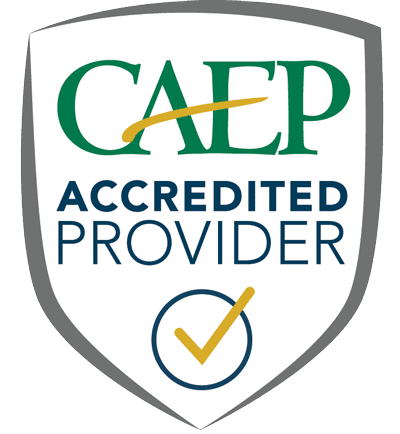Assessment and Accreditation
Annual Reporting Measures
This site provides the EPP’s data for each of the four accountability measures. The four Annual Reporting Measures work together as indicators of EPP performance in relation to candidates as they complete preparation, and to completers once they are on the job.
- Completer Impact and Effectiveness
- Employer Satisfaction and Stakeholder Involvement
- Candidates Competency at the Time of Program Completion
- Ability of Completers to be Hired in Positions for Which They Were Prepared
The EPP’s Self-Study Report will provide analysis of trends, comparisons with benchmarks, identification of changes made in the preparation curricula and experiences, how/where/with whom results are shared, resources allocations affected by the EPP’s uses of the information, and indications of future directions.
Measure 1 (Initial) Completer Impact and Effectiveness
The EPP developed a data collection plan for this measure as follows:
New York State does not offer the EPP access to teacher effectiveness data at a state level. The EPP has used the NYC teacher effectiveness data for graduates and sampled program-level data to cobble together a narrative. We have since fleshed out a more comprehensive model that includes four data sources:
- NYCDOE HEDI growth scores
- The Employer Survey
- Alumni Follow-Up Survey
- The Alumni Impact Study
NYCDOE HEDI Growth Scores are annual ratings received by all teachers in the New York City Department of Education (NYCDOE), with “HEDI” standing for Highly Effective (4), Effective (3), Developing (2), and Ineffective (1). It’s a multiple-measure system combining Measures of Teacher Practice (MOTP) and Measures of Student Learning (MOSL) to assess teacher contributions holistically. The HEDI rating is plotted on a matrix, where Highly Effective requires ratings of Highly Effective on both MOSL and MOTP axes or a mix of Highly Effective and Effective. Effective ratings require either Effective on both axes or a mix of Effective and Developing. Advance, NYC’s teacher development and evaluation system, utilizes MOTP and MOSL to provide feedback and determine personnel decisions, including tenure and Teacher Improvement Plans. As part of a data sharing agreement, CUNY Central provides the EPP with HEDI data on Queens College completers working in DOE schools. Data tables below show HEDI ratings distribution 2 years post-completion of EPP programs
NOTE: The Governor signed Chapter 112 (2021) and Chapter 201 (2022) of the laws. These bills, which passed unanimously in both the senate and assembly, eliminated the requirement for school districts and BOCES to complete an annual professional performance review (APPR) for any classroom teacher or building principal for the 2020-21 & 2021-2022 school years. The bill also assures that state funding will not be withheld from any school district for not completing the APPR in the 2020-21 & 2021-22 school years. Fact Sheet 21-11 (updated): Changes to Annual Professional Performance Review (APPR) (nysut.org)
HEDI Ratings of EPP Completers of Initial Programs 2 Years after Program Completion, by Academic Year of Program Completion
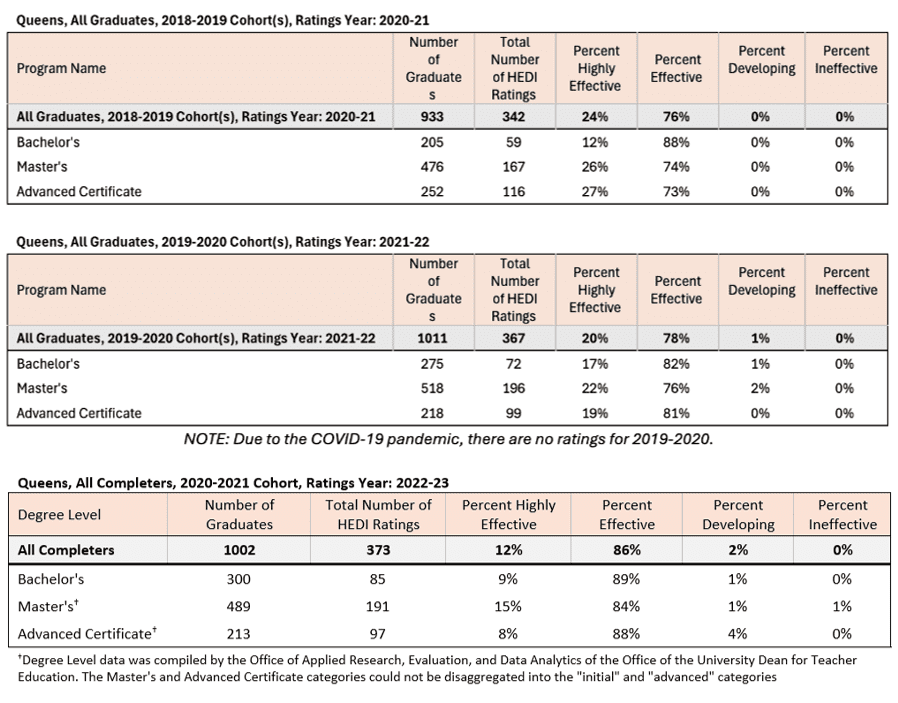
| HEDI Ratings of EPP Completers of Initial Programs 2 Years after Completion, by Program |
| 2018-2019 Cohort(s) Ratings Year: 2020-21 |
| 2019-2020 Cohort(s) Ratings Year: 2021-22 |
| 2020-2021 Cohort(s) Ratings Year: 2022-23 |
Employer Survey – Impact on Student Learning
The EPP measures employer satisfaction with the preparedness of its program completers through the Employer Survey. This survey is vital in assessing how well the EPP prepares its completers to work with diverse P-12 students and their families. Employers evaluate completers’ instructional practices, abilities to work with diverse learners, skills in establishing a positive classroom environment, and professionalism. The survey aligns closely with the Alumni Follow-Up Survey, facilitating direct comparisons between novice teachers’ and supervisors’ perspectives.
Initially, the EPP sent the Employer Survey to employers based on contact information provided by completers in the Alumni Follow-Up Survey. However, the response rate was low with this method. To address this, beginning in the 2023-24 academic year, the EPP invited partner districts to the Queens College campus and hosted district-level principal meetings described in CAEP Standard R2. These meetings provided opportunities to build our clinical partnerships through data sharing, collaborative discussions on clinical experiences, and completion of the Employer Survey. As a result, the EPP collected Employer Surveys from Districts 24, 29, and Queens North High School during the 2023-24 academic year and will collect from Districts 25 and 29 during the 2024-25 academic year. This approach significantly increased the response rate.
When employers were asked “how satisfied are you with the teacher’s impact on their students’ learning growth?”, 90.5% indicated that they were either somewhat satisfied or extremely satisfied.

Alumni Follow-Up Survey – Impact on Student Learning
In 2021, the EPP worked to develop a new Alumni Follow-Up Survey after data from the NExT Alumni Follow-Up Survey was not useful to the continuous improvement efforts of the EPP. The newly developed Alumni Follow-Up Survey aligns with the EPP-developed Completer Survey and Employers Survey to allow for data triangulation. In the Summer of 2022, the EPP piloted the new Alumni Follow-Up Survey with completers from 2020-2021. This allowed the EPP to survey certified alumni who would be teaching for at least a year when receiving the survey.
The survey was sent to 396 initial program completers and 77 advanced program completers who were certified by New York State. Of the 396 initial program completers that received the survey, 15 completers responded. Of the 77 advanced program completers, 9 responded. The data tables below show the responses from alumni related to their satisfaction of their impact on students’ learning growth and their actual APPR ratings (if they were willing to share their ratings with the EPP).
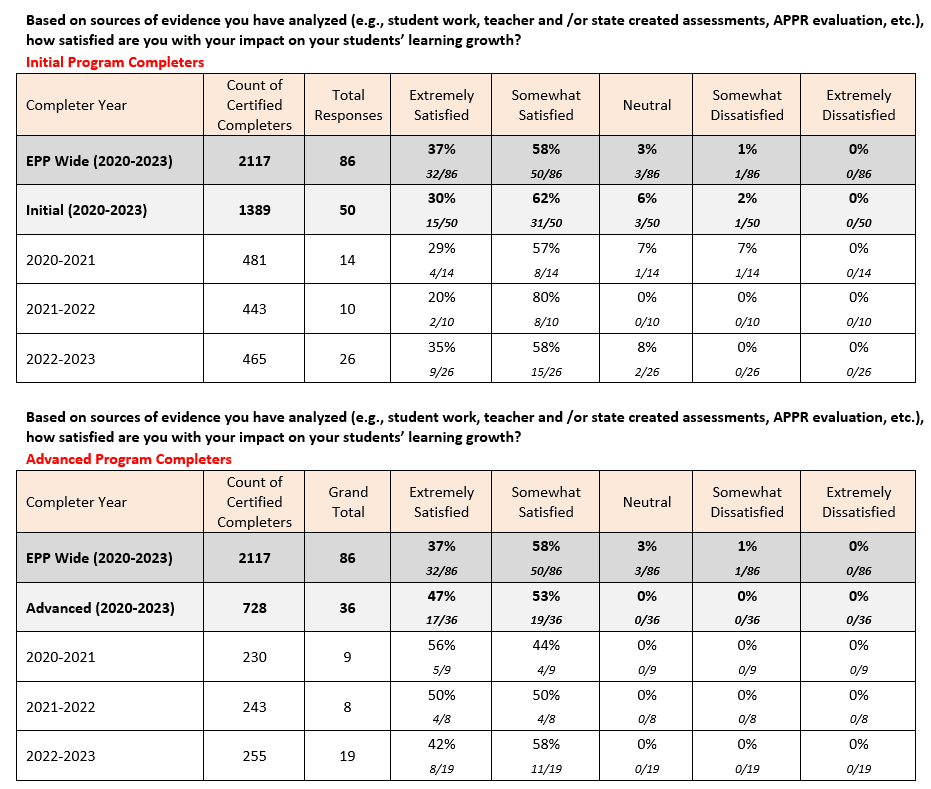
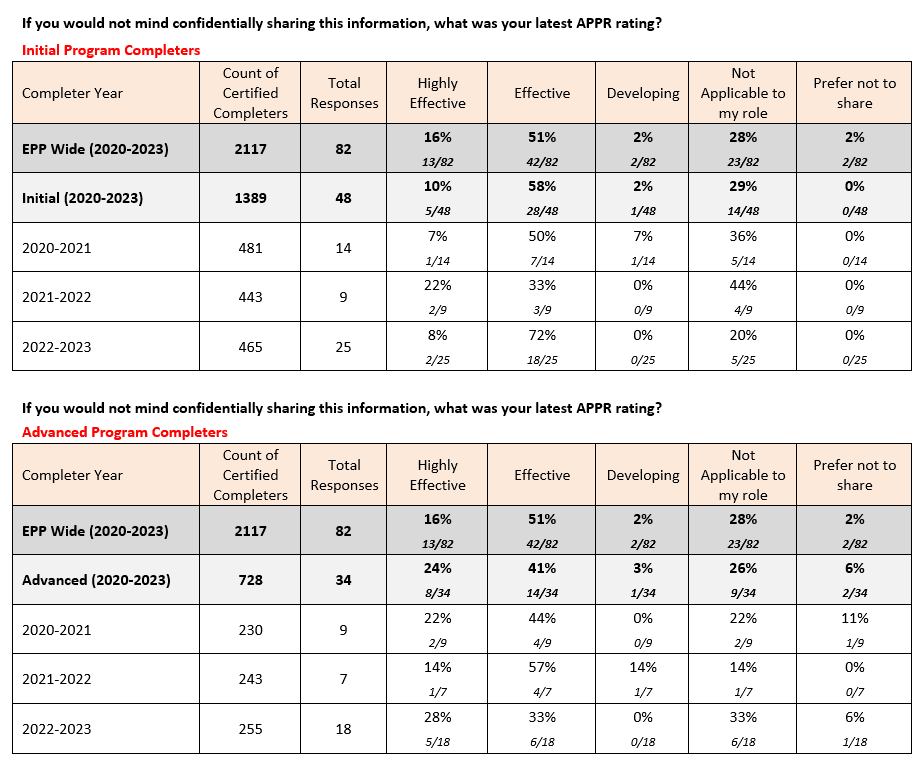
Alumni Follow-Up Survey by Licensure
Alumni Impact Study
The EPP conducts the Alumni Impact Study (AIS) alongside the Alumni Follow-Up Survey and Employer Survey to gauge the influence of completers on student learning. The AIS explores how completers utilize reflective practices and data to enhance instruction and student interactions, fostering growth in academic and non-academic domains. Using interviews, artifacts, and assessments, the study employs rubrics aligned with the Queens College Teacher Portfolio Assessment to track impact on student learning over time. Employing a nested case study approach, the AIS examines individual cases within a broader framework, revealing positive impacts across diverse EPP programs.
Completers who participated in the AIS demonstrated positive impacts on student learning through teaching, assessment, and reflective practice. These alumni represented diverse programs across the EPP, suggesting that the EPP’s mission and conceptual framework are integrated throughout our EPP programs.
Measure 2 (Initial & Advanced) Employer Satisfaction and Stakeholder Involvement
Employer Survey
The EPP measures employer satisfaction with the preparedness of its program completers through the Employer Survey. This survey is vital in assessing how well the EPP prepares its completers to work with diverse P-12 students and their families. Employers evaluate completers’ instructional practices, abilities to work with diverse learners, skills in establishing a positive classroom environment, and professionalism. The survey aligns closely with the Alumni Follow-Up Survey, facilitating direct comparisons between novice teachers’ and supervisors’ perspectives.
Initially, the EPP sent the Employer Survey to employers based on contact information provided by completers in the Alumni Follow-Up Survey. However, the response rate was low with this method. To address this, beginning in the 2023-24 academic year, the EPP invited partner districts to the Queens College campus and hosted district-level principal meetings described in CAEP Standard R2. These meetings provided opportunities to build our clinical partnerships through data sharing, collaborative discussions on clinical experiences, and completion of the Employer Survey. As a result, the EPP collected Employer Surveys from Districts 24, 29, and Queens North High School during the 2023-24 academic year and will collect from Districts 25 and 29 during the 2024-25 academic year. This approach significantly increased the response rate.
On a scale of 1 to 10, employers rated the EPP’s effectiveness in preparing teachers for their current roles at 8, indicating high satisfaction with the educator preparation programs at Queens College. Employers also rated completers’ preparation to teach and their beliefs as teachers on a scale of 1 to 5 (with “1” being “strongly disagree” and “5” being “strongly agree”). The data shows that employers are satisfied with how the programs have prepared their teachers, with average ratings ranging from 3.61 to 4.3 for teaching preparation and 3.78 to 4.17 for beliefs as a teacher. Areas where employers rated completers slightly lower include forming partnerships with the community to optimize learning outside of the classroom, identifying and responding to the mental health needs of students, and ensuring that social inequities and biases are addressed in the classroom. Despite these lower ratings, 100% of the employers indicated they would recommend the Queens College education programs to other prospective candidates.

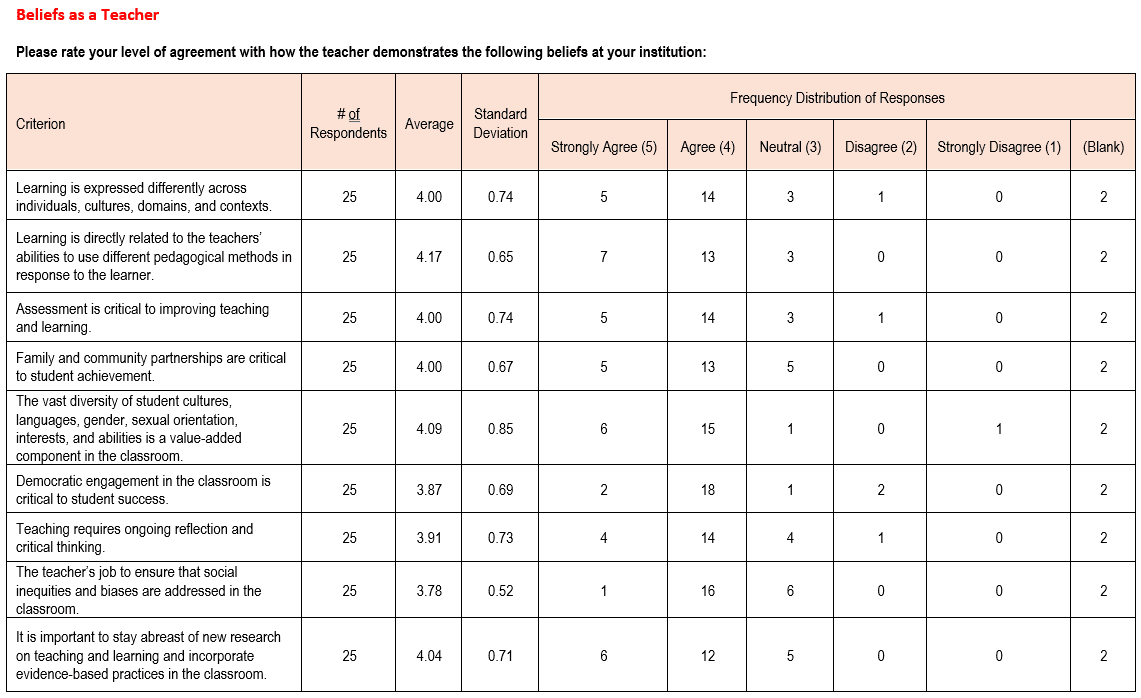

NExT Employer Survey Results 2020
The NExT Employer Survey was administered every year following the administration of the NExT Transitions to Teaching Survey to Alumni. The NExT Transitions to Teaching Survey was administered 1 year after program completion in which candidates were asked to provide information regarding their current employment. The first administration of the NExT Transitions to Teaching Survey was during the spring of 2020 and the NExT Employer Survey was first administered during the summer of 2020.
In spring 2020, the NExT: Transition to Teaching Survey was sent via SurveyMonkey to alumni. The EPP had access to valid emails for 400 of the 2018-2019 completers. The EPP received 90 responses from the pool of 400, with 28 providing valid employer school names. During a major health crisis, the low response rate, while not ideal was also not surprising. Nine respondents provided supervisor emails and of the nine employers, 2 completed the NExT Employer Survey. Only one employer responded to the additional questions added to the survey by the EPP. The low response rate triggered the EPP to move away from the NExT surveys and develop surveys that were more aligned to the needs of the EPP. The EPP-developed Employer Survey was first administered in Fall 2023. We continue to collect data on out Employers’ satisfaction. This data will be made available during the next reporting cycle.
Please view the results of the prior EPP Employer survey for prior years at the links below.
2019 EPP Employer Survey Results
2018 EPP Employer Survey Results
Measure 3 (Initial & Advanced) Candidates Competency at the Time of Program Completion
Teacher Certification Exams
This report contains the pass rates for EPP Completers for the certification exams required for NY State Teacher Certification. The data files were obtained from edReports Results Analyzer. If a candidate took an exam more than once only the best attempt is included in the results. The data is disaggregated by Licensure Area and academic year of program completion.
EAS
In the past 3 academic years completers of an EPP Undergraduate Initial program have had an average 91% pass rate on the EAS exam. The completers of Graduate Initial programs had an overall pass rate of 96% for the past 3 academic years.
CST
The data is disaggregated for Initial and Advanced programs and by licensure area and academic year of completion. A completer may be required to take more than one exam, i.e., for Elementary Initial Certification, a candidate is required to take the MS 1-6 Part One Lit/ELA, the MS 1-6 Part Two Math, and the MS Part Three Arts & Science exams. Overall, the completers of an EPP Undergraduate Initial program had an average 88% pass rate on the CST exam for the past 3 academic years. The completers of a Graduate Initial programs have had a 93% pass rate on the CST exams. The completers of Graduate Advanced programs had an overall pass rate of 95% for the past 3 academic
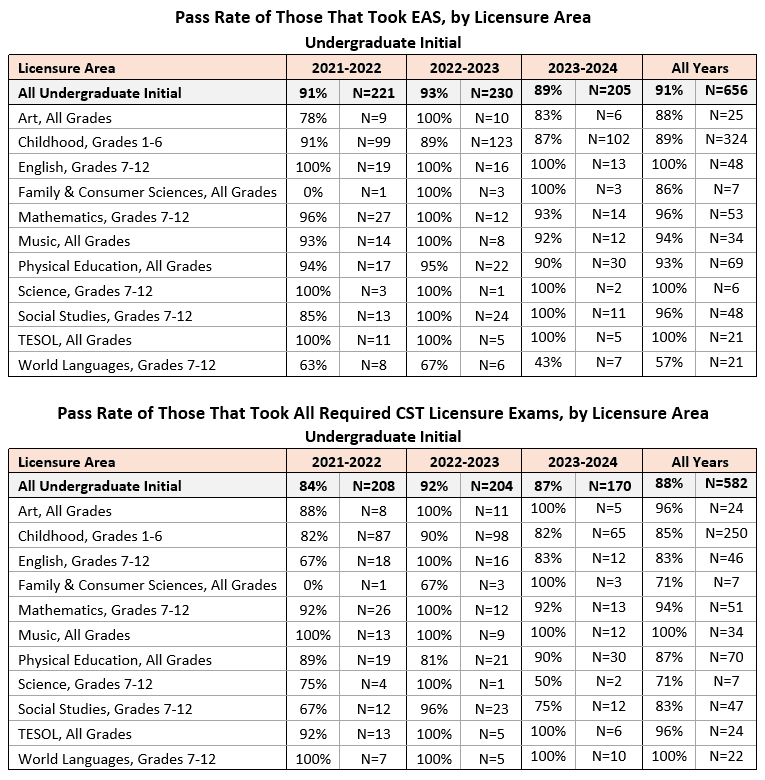
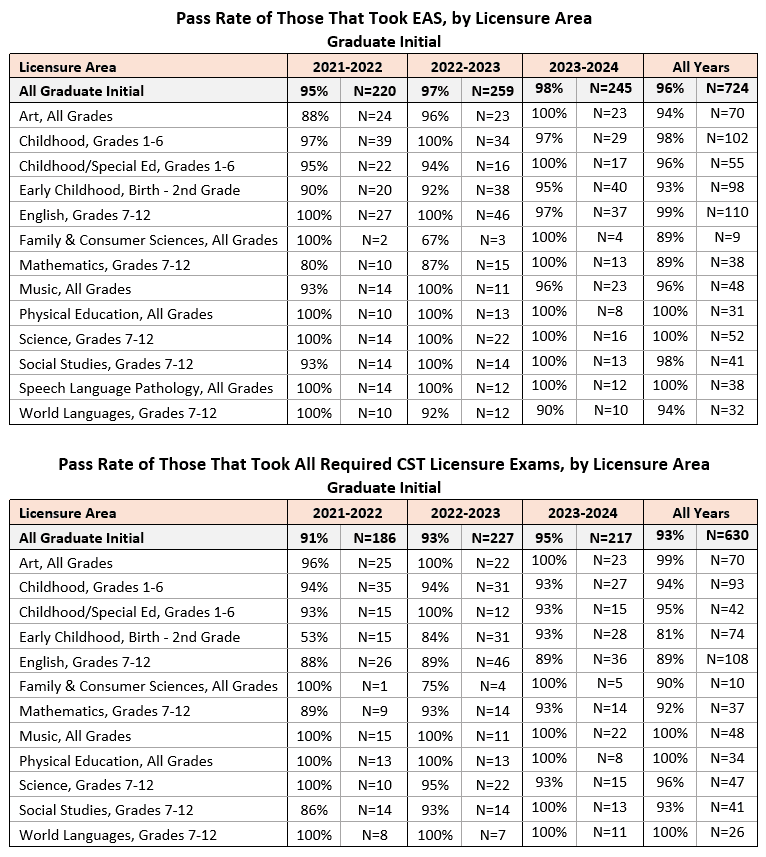

Measure 4 (Initial & Advanced) Ability of Completers to be Hired in Positions for Which They Were Prepared
Total Queens College EPP Completers Hired by NYC DOE by Completer Year
As part of the CUNY-DOE data sharing agreement, CUNY Central annually provides the EPP with data on Queens College completers that are working as pedagogues in DOE schools. The table below contains the counts and percentages of completers that have obtained employment with the NYC DOE.
As of as of March 2024, 63% of the 2021-2022 Completers of an EPP program had been employed by the NYC DOE. Of the initial completers that were employed by the DOE, approximately 97% received employment within 2 years of program completion. Candidates of Graduate Advanced programs are more likely to already be employed with the NYC DOE prior to program completion.
Please note that the most recent years of data provided to the EPP are represented below. Data for 2023-2024 will be available to the EPP next year.
Total Queens College EPP Completers Hired by NYC DOE by Completer Year
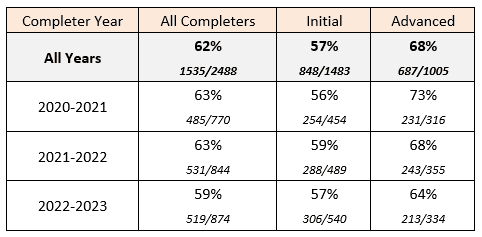
Count and Percent of Completers Employed by the NYC DOE by Academic Year of Completion and Licensure Area
When are Queens College EPP Completers Hired by NYC DOE in Relation to Program Completion?
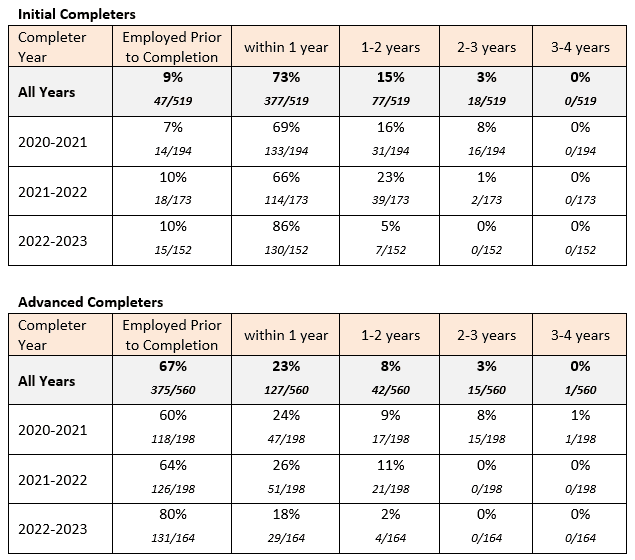 2020-2023 Completers by Licensure Area
2020-2023 Completers by Licensure Area
Sonia Rodrigues
Director of Assessment and Accreditation
sonia.rodrigues@qc.cuny.edu
Powdermaker Hall 137A
718-997-5219
Beata Breg
Assessment Coordinator
beata.breg@qc.cuny.edu
Powdermaker Hall 137B
718-997-5206
Mark Bannick
Anthology Coordinator
mark.bannick@qc.cuny.edu
Powdermaker Hall 137
718-997-5245


